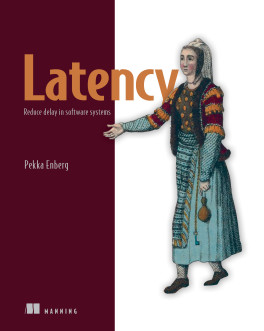pro $24.99 per month
- access to all Manning books, MEAPs, liveVideos, liveProjects, and audiobooks!
- choose one free eBook per month to keep
- exclusive 50% discount on all purchases
- renews monthly, pause or cancel renewal anytime
lite $19.99 per month
- access to all Manning books, including MEAPs!
team
5, 10 or 20 seats+ for your team - learn more

Look inside
Practical techniques for delivering low latency software.
From first principles to production-ready code, Latency teaches you how to make your software faster at every layer of the stack. You’ll learn what latency really is, how it differs from bandwidth, and why it matters for user experience. Then, guided by practical examples, you’ll apply Little’s Law, design lock-free algorithms, and architect caching systems that scale. You’ll discover how your code runs differently on distributed systems, databases, and operating systems, and understand the common latency-causing issues in each situation.
In Latency you’ll learn how to:
Put simply, latency is the delay between a cause and effect. In practice, too much latency can create problems throughout a software system, ranging from inaccurate calculations and timeouts to impatient users simply abandoning your applications. Latency issues can be challenging to avoid and troubleshoot. This book balances theory with practical implementations, turning academic research into useful techniques you can apply to your projects.
From first principles to production-ready code, Latency teaches you how to make your software faster at every layer of the stack. You’ll learn what latency really is, how it differs from bandwidth, and why it matters for user experience. Then, guided by practical examples, you’ll apply Little’s Law, design lock-free algorithms, and architect caching systems that scale. You’ll discover how your code runs differently on distributed systems, databases, and operating systems, and understand the common latency-causing issues in each situation.
In Latency you’ll learn how to:
- Define latency, distinguish it from bandwidth, and understand its impact on user experience
- Model performance with Little’s Law and Amdahl’s Law, then measure and visualize delays
- Optimize data access with colocation, replication, partitioning, and caching
- Accelerate logic with algorithmic improvements, memory tuning, and lock-free concurrency
- Minimize delays with asynchronous processing, predictive techniques, and speculative execution
Put simply, latency is the delay between a cause and effect. In practice, too much latency can create problems throughout a software system, ranging from inaccurate calculations and timeouts to impatient users simply abandoning your applications. Latency issues can be challenging to avoid and troubleshoot. This book balances theory with practical implementations, turning academic research into useful techniques you can apply to your projects.
about the technology
From lost microseconds routing server messages to page loads that keep users waiting, latency can kill good software. This one-of-a-kind book shows you how to spot, understand, and fix unwanted latency in your applications and infrastructure.about the book
Latency: Reduce delay in software systems shows you how to troubleshoot latency in existing applications and create low latency systems from the ground up. In it, you’ll discover high-impact fixes for measuring latency and advanced optimizations in memory management, concurrency models, and predictive execution. The tips and tricks, hands-on projects, and personal insights make this book as enjoyable as it is practical.what's inside
- How to model and measure latency
- Organizing application data for low latency
- Accelerating your code
- Hiding latency
Enlightening read and hugely recommended for all practitioners.
Easy to follow explanations and practical examples and diagrams.
Great resource for distributed systems engineers!
A must read for anyone working on latency-sensitive projects.
Provides a broad understanding of latency.
choose your plan
team
monthly
annual
$49.99
$399.99
only $33.33 per month
- five seats for your team
- access to all Manning books, MEAPs, liveVideos, liveProjects, and audiobooks!
- choose another free product every time you renew
- choose twelve free products per year
- exclusive 50% discount on all purchases
- renews monthly, pause or cancel renewal anytime
- renews annually, pause or cancel renewal anytime
-
![]() Latency ebook for free
Latency ebook for free
choose your plan
team
monthly
annual
$49.99
$399.99
only $33.33 per month
- five seats for your team
- access to all Manning books, MEAPs, liveVideos, liveProjects, and audiobooks!
- choose another free product every time you renew
- choose twelve free products per year
- exclusive 50% discount on all purchases
- renews monthly, pause or cancel renewal anytime
- renews annually, pause or cancel renewal anytime
-
![]() Latency ebook for free
Latency ebook for free
choose your plan
team
monthly
annual
$49.99
$399.99
only $33.33 per month
- five seats for your team
- access to all Manning books, MEAPs, liveVideos, liveProjects, and audiobooks!
- choose another free product every time you renew
- choose twelve free products per year
- exclusive 50% discount on all purchases
- renews monthly, pause or cancel renewal anytime
- renews annually, pause or cancel renewal anytime
-
![]() Latency ebook for free
Latency ebook for free



















 Latency ebook for free
Latency ebook for free